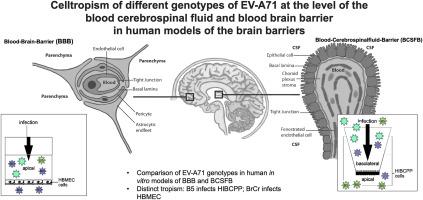EV-A71在人血脑脊液和血脑屏障上的基因型依赖性细胞趋向性
IF 3.5
3区 医学
Q3 IMMUNOLOGY
引用次数: 0
摘要
背景肠病毒a71 (EV-A71)已在世界范围内引起重大流行。虽然它最常与手足口病(手足口病)或非特异性表现为上呼吸道或下呼吸道感染有关,但它也可导致严重的神经系统症状,特别是在幼儿中。目前还缺乏对EV-A71侵袭中枢神经系统的发病机制以及嗜神经亚基因型的详细了解。方法采用人脉络膜丛乳头瘤细胞(HIBCPP)血脑脊液屏障(BCSFB)体外模型和人脑微血管内皮细胞(HBMEC)血脑屏障(BBB)体外模型,在脑屏障水平评估sev - a71感染情况。比较BrCr、B5、C1、C1-like、C2、C4 6种临床相关基因型。除了全球闻名的EV-A71和C2参考菌株BrCr外,之所以选择C1和C1样菌株,是因为它们主要在欧洲传播,而C4和B5主要在亚太地区传播。通过光镜和免疫荧光染色对感染进行定性分析。通过qPCR对病毒基因组拷贝数进行定量。同时,通过测量经上皮阻力来监测BCSFB屏障的完整性。采用LIVE/DEAD法进行活力对照。结果shibcpp细胞和HBMEC对EV-A71不同基因型BrCr、B5、C1、C1样、C2和C4感染的易感性存在差异。在两种模型中,没有一种菌株引起溶解性感染,与在RD细胞中的感染相反。在HIBCPP细胞中作为BCSFB的模型,B5导致最高的感染率。与BrCR(30.39±8.11%)、C1(8.73±8.89%)、C1样(23.90±17.28%)、C2(16.89±8.95%)和C4(21.46±3.16%)相比,B5(56.42±7.13%)的病毒子代向脑脊液侧的极性释放有显著差异。在HBMEC作为血脑屏障模型中,与其他基因型相比,BrCr显示出显著更高的顶端释放。pBrCr vs.B5在24 h和48 h的p值最小(0.0019),而pBrCr vs.B5在72 h的p值最大(0.0379)。结论不同基因型的EV-A71在脑屏障水平表现出不同的趋同性,这可能与临床感染过程的差异有关。除了目前在亚太地区建立的监测外,有必要对EV感染进行临床和分子监测。本文章由计算机程序翻译,如有差异,请以英文原文为准。

Genotype-dependent cell tropism of EV-A71 at the human blood cerebrospinal fluid and blood brain barrier
Background
Enterovirus A 71 (EV-A71) has caused major epidemics worldwide. While it is most commonly associated with Hand-Foot-Mouth Disease (HFMD) or nonspecific presentations as upper or lower respiratory tract infection, it can also lead to severe neurologic manifestations especially in young children. Detailed understanding of the pathogenesis of EV-A71 CNS invasion as well as of the neurotropic subgenotypes is currently lacking.
Methods
EV-A71 infection at the level of the brain barriers was assessed with human in vitro models of the Blood-Cerebrospinal Fluid Barrier (BCSFB) using Human choroid plexus papilloma (HIBCPP) cells and the Blood-Brain Barrier (BBB) using Human brain microvascular endothelial cells (HBMEC). Six clinically relevant genotypes, namely BrCr, B5, C1, C1-like, C2 and C4 were compared. Besides BrCr, the reference strain for EV-A71 and C2, which is known for its worldwide presence, C1 and C1-like were chosen as they are mainly circulating in Europe whereas C4 and B5 are mainly known from the Asian-Pacific region. Infection was analyzed qualitatively via cytopathic effect (CPE) with light microscopy and immunofluorescence staining. Quantification of viral genome copies was performed via qPCR. In parallel, barrier integrity of the BCSFB was monitored via measurement of transepithelial resistance. LIVE/DEAD assays were applied for viability controls.
Results
HIBCPP cells and HBMEC differed in their susceptibility to infection with different genotypes of EV-A71 namely BrCr, B5, C1, C1-like, C2 and C4. None of the strains caused a lytic infection in either model, in contrast to infection in RD cells. In HIBCPP cells as a model for the BCSFB, B5 led to the highest infection rates. Significant differences in the polar release of viral progeny to the CSF side were detected for B5 (56.42 ± 7.13 %) compared to BrCR (30.39 ± 8.11 %), C1 (8.73 ± 8.89 %), C1-like (23.90 ± 17.28 %), C2 (16.89 ± 8.95 %) and C4 (21.46 ± 3.16 %). In HBMEC as a model for the BBB, BrCr showed significantly higher apical release compared to the other genotypes. The minimum p-value (0.0019) was recorded for pBrCr vs.B5 at 24 h and 48 h, while the maximum p-value (0.0379) was observed for pBrCr vs.B5 at 72 h.
Conclusion
Our findings reveal that different genotypes of EV-A71 exhibit distinct tropisms at the level of the brain barriers, which may correlate with variations in the clinical course of infection. Clinical and molecular surveillance of EV infections beyond those currently established in the Asia-Pacific region is warranted.
求助全文
通过发布文献求助,成功后即可免费获取论文全文。
去求助
来源期刊

Microbial pathogenesis
医学-免疫学
CiteScore
7.40
自引率
2.60%
发文量
472
审稿时长
56 days
期刊介绍:
Microbial Pathogenesis publishes original contributions and reviews about the molecular and cellular mechanisms of infectious diseases. It covers microbiology, host-pathogen interaction and immunology related to infectious agents, including bacteria, fungi, viruses and protozoa. It also accepts papers in the field of clinical microbiology, with the exception of case reports.
Research Areas Include:
-Pathogenesis
-Virulence factors
-Host susceptibility or resistance
-Immune mechanisms
-Identification, cloning and sequencing of relevant genes
-Genetic studies
-Viruses, prokaryotic organisms and protozoa
-Microbiota
-Systems biology related to infectious diseases
-Targets for vaccine design (pre-clinical studies)
 求助内容:
求助内容: 应助结果提醒方式:
应助结果提醒方式:


